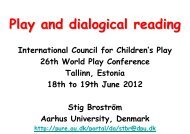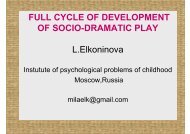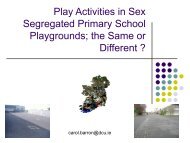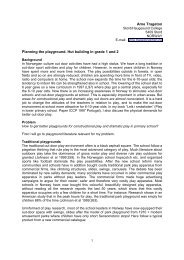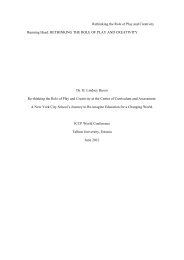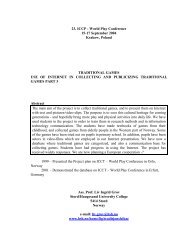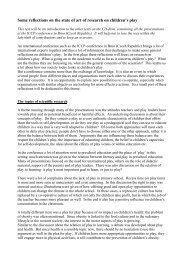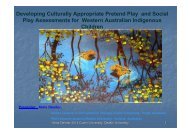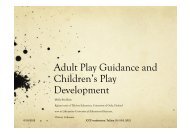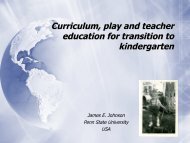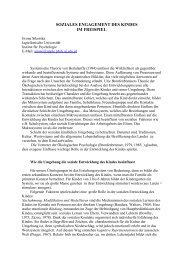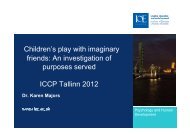Alice M. Meckley, Ph.D. Play Communities in the Early Childhood ...
Alice M. Meckley, Ph.D. Play Communities in the Early Childhood ...
Alice M. Meckley, Ph.D. Play Communities in the Early Childhood ...
Create successful ePaper yourself
Turn your PDF publications into a flip-book with our unique Google optimized e-Paper software.
<strong>Alice</strong> M. <strong>Meckley</strong>, <strong>Ph</strong>.D.<br />
Millersville University<br />
Department of Elementary and <strong>Early</strong> <strong>Childhood</strong> Education<br />
Millersville, PA 17551<br />
U.S.A.<br />
<strong>Play</strong> <strong>Communities</strong> <strong>in</strong> <strong>the</strong> <strong>Early</strong> <strong>Childhood</strong> Classroom<br />
Abstract<br />
This paper proposes that play communities, socially constructed by young children <strong>in</strong><br />
educational sett<strong>in</strong>gs, are important contexts of communication, <strong>in</strong>teraction, and learn<strong>in</strong>g.<br />
Communication is an <strong>in</strong>tegral part of <strong>the</strong> successful creation and management of play with<strong>in</strong> a<br />
specific group of children. Interaction between players and play groups and connections<br />
between subjective and collective understand<strong>in</strong>gs of <strong>the</strong> social play form <strong>the</strong> basis of community.<br />
Shared knowledge of play events, of play environments (space and materials), and of <strong>the</strong><br />
common play <strong>in</strong>terests of <strong>in</strong>dividuals are important to young children's creation and ma<strong>in</strong>tenance<br />
of play communities. Learn<strong>in</strong>g is promoted through <strong>in</strong>dividual knowledge, symbolic<br />
understand<strong>in</strong>g, and social <strong>in</strong>teraction. Discussion of data from two longitud<strong>in</strong>al research studies,<br />
conducted <strong>in</strong> preschool classrooms, will demonstrate that play communities are vital elements<br />
of <strong>the</strong> early childhood classroom. The process of document<strong>in</strong>g <strong>the</strong> creation and management of<br />
play communities will be shared. The factors that encourage or discourage <strong>the</strong> development of<br />
play communities will be exam<strong>in</strong>ed.<br />
Introduction<br />
The early childhood classroom is a place <strong>in</strong> society where children and adults meet and<br />
participate toge<strong>the</strong>r <strong>in</strong> a community of social, cultural, and symbolic significance (Dahlberg,<br />
Moses, & Pence, 1999). The amount of autonomy given to <strong>the</strong> children <strong>in</strong> <strong>the</strong> classroom<br />
depends on <strong>the</strong> adults, who are <strong>in</strong> charge of <strong>the</strong> time, environment, materials, and activities ...<br />
<strong>the</strong> curriculum. Adults have goals and ideas about what should be taught and learned; children<br />
also have ideas about what <strong>the</strong>y want to do <strong>in</strong> this group, often choos<strong>in</strong>g social activities. The<br />
comb<strong>in</strong>ed goals, shared experiences, and physical <strong>in</strong>volvement of adults and children create <strong>the</strong><br />
classroom community.<br />
In <strong>the</strong> early childhood classroom community, <strong>the</strong> children's predom<strong>in</strong>antly chosen activity<br />
of social <strong>in</strong>teraction is play. Social play is a preferred activity of young children. Additionally,<br />
play is a common phenomenon with<strong>in</strong> <strong>the</strong> child culture unique to <strong>the</strong> young children with<strong>in</strong> a<br />
specific classroom community. Children as young as 3 years and 4 years of age construct social<br />
play toge<strong>the</strong>r <strong>in</strong> a specific early childhood classroom (Paley, 1988; <strong>Meckley</strong>, 1994b).<br />
The creation and <strong>in</strong>vention of play beg<strong>in</strong>s when one or more children engage <strong>in</strong> a set of<br />
actions or an action plan (Garvey, 1990); a plan for play may or may not be verbalized. But <strong>the</strong><br />
play cont<strong>in</strong>ues <strong>in</strong> a purposeful comb<strong>in</strong>ation of actions and/or words that is ordered and may be<br />
repeated aga<strong>in</strong>. Such repetition assures that a particular set of actions will become a common<br />
play event. As a play event develops, o<strong>the</strong>r children <strong>in</strong> this class may jo<strong>in</strong>, watch, leave and<br />
arrive. The social construction of a play event cont<strong>in</strong>ues <strong>in</strong> this particular time and sett<strong>in</strong>g.<br />
However, not only is one play event or action plan enacted <strong>in</strong> a given classroom play community<br />
of children, but several simultaneous play events are also occurr<strong>in</strong>g <strong>in</strong> o<strong>the</strong>r sett<strong>in</strong>gs nearby.<br />
Although many different events are happen<strong>in</strong>g concurrently, <strong>the</strong> group of children ma<strong>in</strong>ta<strong>in</strong>s<br />
elements of order and consistency through shared knowledge of <strong>the</strong> play. This multi-layered<br />
description of creation and ma<strong>in</strong>tenance illum<strong>in</strong>ates <strong>the</strong> nature of <strong>the</strong> social construction of<br />
young children's play (<strong>Meckley</strong>, 1994b). As children construct social play toge<strong>the</strong>r <strong>the</strong>y become<br />
members of early childhood play communities.<br />
<strong>Early</strong> childhood play community is here def<strong>in</strong>ed as a group of young players who<br />
voluntarily share <strong>in</strong> <strong>the</strong> creation and ma<strong>in</strong>tenance of one or more play events through mutual<br />
1 / 10
<strong>in</strong>terests, social <strong>in</strong>teractions, communication, and negotiation. This def<strong>in</strong>ition is based on John<br />
Dewey’s attributes necessary for formation of a true community. Accord<strong>in</strong>g to Dewey, a viable<br />
community is def<strong>in</strong>ed through <strong>the</strong> components of shared common <strong>in</strong>terests, cooperative social<br />
<strong>in</strong>teraction, and communication between (play) groups (Dewey 1966, p. 5, 24, 87).<br />
Communication creates knowledge and depends on <strong>the</strong> shar<strong>in</strong>g of actions, ideas, and<br />
feel<strong>in</strong>gs with o<strong>the</strong>rs … self-disclosure and self-understand<strong>in</strong>g through shared common <strong>in</strong>terests.<br />
“Communication depends on community” (Fogel, 1993, p. 12). Community is where culture<br />
exists with all <strong>the</strong> necessary rules for social understand<strong>in</strong>g … which may occur as early as 3<br />
years of age when children show a clear grasp of context-specific rules (Dunn, 1988).<br />
“Culturally accepted behavior arises spontaneously as part of children’s <strong>in</strong>teractions with o<strong>the</strong>rs”<br />
(Fogel, 1993, p. 13).<br />
Therefore, social activities with<strong>in</strong> communities and cultures may be <strong>the</strong> most important<br />
contexts for children's learn<strong>in</strong>g. <strong>Play</strong>, as a socially ubiquitous and cultural experience <strong>in</strong> early<br />
childhood, becomes <strong>the</strong> primary contextual experience through which children view and ga<strong>in</strong><br />
understand<strong>in</strong>g of <strong>the</strong>mselves as "social <strong>in</strong>dividuals" (Dewey, 1897; Cuffaro, 1995). The culture of<br />
society is reflected and understood <strong>in</strong> <strong>the</strong> child culture of play.<br />
In <strong>the</strong> early childhood classroom, play communities are created and ma<strong>in</strong>ta<strong>in</strong>ed by <strong>the</strong><br />
children as players. Adults may encourage or discourage play communities and thus <strong>in</strong>fluence<br />
children’s social, cultural and symbolic learn<strong>in</strong>g.<br />
The purpose of this paper is to discuss data uncovered <strong>in</strong> two longitud<strong>in</strong>al five-month<br />
research studies conducted <strong>in</strong> two different but similar classrooms with two different ages of<br />
children. Does an exam<strong>in</strong>ation of <strong>the</strong> nature and components of early childhood play<br />
communities validate <strong>the</strong>se communities as important to social <strong>in</strong>teraction, communication, and<br />
learn<strong>in</strong>g? What are <strong>the</strong> differences that may be caused by <strong>the</strong> age of <strong>the</strong> children?<br />
Two Longitud<strong>in</strong>al Research Studies<br />
Methodology<br />
Two longitud<strong>in</strong>al research studies were conducted: one <strong>in</strong> a class of 3 year old children<br />
and one <strong>in</strong> a class of 4 year old children. In both studies, <strong>the</strong> primary research purpose was to<br />
document <strong>the</strong> cont<strong>in</strong>uous flow of collective, <strong>in</strong>teractive, simultaneous play events with<strong>in</strong> and<br />
between familiar players and play groups over a long period of time. These studies are based<br />
on <strong>the</strong> premise that <strong>in</strong> order to understand children's social play construction, <strong>the</strong> researcher<br />
must use a child cultural, contextual, and group not <strong>in</strong>dividual play perspective (<strong>Meckley</strong>,<br />
1994b).<br />
Each research study encompassed a five-month period from January to May <strong>in</strong> an early<br />
childhood classroom <strong>in</strong> <strong>the</strong> same school located <strong>in</strong> a suburban neighborhood. The school's<br />
program philosophy follows a developmental learn<strong>in</strong>g model based on <strong>in</strong>tegrated curriculum and<br />
a partnership between home and school as stated <strong>in</strong> <strong>the</strong> Information Book. Each classroom<br />
has spacious, well-equipped rooms and teachers tra<strong>in</strong>ed <strong>in</strong> early childhood education.<br />
Each class was selected based on: 1) <strong>the</strong> age of <strong>the</strong> children; 2) <strong>the</strong> teacher's<br />
commitment to <strong>the</strong> value of play; and 3) <strong>the</strong> amount of time <strong>in</strong> each session given for children's<br />
self-selected play, averag<strong>in</strong>g 25% per session over <strong>the</strong> entire study. These are important criteria<br />
for young children's quality social pretend play as documented by Bre<strong>the</strong>rton (1984), Christie<br />
and Wardle (1992), and Fe<strong>in</strong> and Schwartz (1986).<br />
Additionally, <strong>the</strong> children <strong>in</strong> each class attended school for 3 days each week for 2 and a<br />
1/2 hours each day. These groups of children were very evenly matched <strong>in</strong> all factors except<br />
age. Therefore, <strong>the</strong> variable of age becomes significant <strong>in</strong> compar<strong>in</strong>g <strong>the</strong> play constructions of<br />
each class.<br />
The 4 year olds class was composed of 12 four- and five-year-old children, 6 boys and 6<br />
girls. Mean age was 4 years 9 months. The 3 year olds class was composed of 13 three- and<br />
four-year-old children, 9 boys and 4 girls. Mean age was 3 years 10 months. The majority of <strong>the</strong><br />
children came from middle-class families of similar backgrounds <strong>in</strong> culture and socioeconomic<br />
factors.<br />
2 / 10
The author and a student research assistant observed each group's social play for an<br />
average of 28 consecutive class sessions over a five month period from January to May. S<strong>in</strong>ce<br />
<strong>the</strong> children <strong>in</strong> each class had been play<strong>in</strong>g toge<strong>the</strong>r as a group s<strong>in</strong>ce September, this time<br />
frame guaranteed a group of familiar players. The study was undertaken from an ethnographic<br />
perspective; <strong>the</strong> researcher’s role was observer as participant (see Hammersley & Atk<strong>in</strong>son,<br />
1983, Chapter 4, for complete description of this research role). Each researcher took notes and<br />
<strong>in</strong>teracted with <strong>the</strong> children <strong>in</strong> a m<strong>in</strong>imal way. Children were regularly <strong>in</strong>formed at ga<strong>the</strong>r<strong>in</strong>g<br />
times that <strong>the</strong> researcher was <strong>in</strong>terested <strong>in</strong> <strong>the</strong>ir play; <strong>the</strong>ir comments were encouraged at any<br />
time.<br />
Data was collected through field notes, audio and video tap<strong>in</strong>g, <strong>in</strong>terviews, surveys and<br />
meet<strong>in</strong>gs with parents and teachers, and comments of children and teachers as <strong>the</strong>y watched<br />
<strong>the</strong> taped play.<br />
The data collection unit was a play event occurr<strong>in</strong>g dur<strong>in</strong>g playtime. The components of<br />
<strong>the</strong>se events <strong>in</strong>volved participants, sett<strong>in</strong>g, time, objects, action sequence, and language. An<br />
event was def<strong>in</strong>ed by <strong>the</strong> participants through <strong>the</strong> actions (e.g. body posture, gaze) and<br />
language (e.g. nam<strong>in</strong>g <strong>the</strong> play activity). As much as possible, all participants were located <strong>in</strong><br />
sett<strong>in</strong>g and time throughout each session's play time periods. A context cod<strong>in</strong>g system was<br />
used <strong>in</strong> data collection and analysis (<strong>Meckley</strong> & Sheaffer, 2000)<br />
As many as six concurrent events were documented as occurr<strong>in</strong>g at any given time.<br />
Actions, words, and objects were added to activity descriptions as noted. Audio and video<br />
tap<strong>in</strong>g with <strong>the</strong> use of two cameras and six suspended microphones, record<strong>in</strong>g events <strong>in</strong><br />
different sett<strong>in</strong>gs of <strong>the</strong> room simultaneously, yielded a significant amount of <strong>in</strong>formation<br />
concern<strong>in</strong>g <strong>the</strong> play events.<br />
A detailed chronological context map of <strong>the</strong> events dur<strong>in</strong>g play was done for each<br />
observed day. <strong>Play</strong> events and daily events were listed <strong>in</strong> order of occurrence and coded across<br />
<strong>the</strong> follow<strong>in</strong>g dimensions: event order throughout day; duration; sett<strong>in</strong>g; participants and<br />
absentees; objects used <strong>in</strong> play; actions of players and play groups dur<strong>in</strong>g events; and words<br />
stated dur<strong>in</strong>g play. Analysis of this context map resulted <strong>in</strong> <strong>the</strong> documentation of sixty (60)<br />
dist<strong>in</strong>ct play events <strong>in</strong> <strong>the</strong> 4 year old class and thirty (30) play events <strong>in</strong> <strong>the</strong> 3 year old class. A<br />
<strong>Play</strong> Event Descriptive Summary was completed for <strong>the</strong> play events <strong>in</strong> each class, enabl<strong>in</strong>g <strong>the</strong><br />
researcher to group events by key components of sett<strong>in</strong>g, players, actions, and/or objects.<br />
Results<br />
Of <strong>the</strong> many play events documented over <strong>the</strong> five month study <strong>in</strong> each early childhood<br />
classroom (60 events <strong>in</strong> <strong>the</strong> 4 year olds class and 30 events <strong>in</strong> <strong>the</strong> 3 year olds class), two<br />
particular play events (one event from each age group) will be analyzed and discussed. These<br />
two play events were created by <strong>the</strong> children <strong>in</strong> play communities observed dur<strong>in</strong>g <strong>the</strong> study and<br />
ma<strong>in</strong>ta<strong>in</strong>ed by <strong>the</strong> children through communication of play knowledge. Additionally, <strong>the</strong>se two<br />
play events <strong>in</strong>creased social <strong>in</strong>teraction <strong>in</strong> each classroom and promoted learn<strong>in</strong>g <strong>in</strong>dependent<br />
of <strong>the</strong> teacher or school curriculum.<br />
In <strong>the</strong> 4 year olds class, <strong>the</strong> play event named Blaster is representative of communication<br />
and shared common <strong>in</strong>terest <strong>in</strong> play communities. In <strong>the</strong> 3 year olds class <strong>the</strong> play event named<br />
Laser is representative of cooperative social <strong>in</strong>teraction and culture <strong>in</strong> play communities.<br />
Blaster is an excellent example of how play knowledge is communicated from a play<br />
community to <strong>the</strong> rest of <strong>the</strong> children <strong>in</strong> <strong>the</strong> class. The construct<strong>in</strong>g of a unique complex block<br />
structure began this play event. The construction was accomplished through <strong>the</strong> direction of a<br />
boy, usually Jason, who was <strong>the</strong> play leader. In addition to <strong>the</strong> time-consum<strong>in</strong>g construction and<br />
preparation of this structure called a Blaster, a sequence of actions l<strong>in</strong>ked to this block structure<br />
identified this specific play event whenever it occurred.<br />
When each play event first occurred <strong>the</strong>n potentially reoccurred throughout this five<br />
month study, it followed a sequence of actions <strong>in</strong>clud<strong>in</strong>g use of specific objects by specific<br />
players, a play community, that identified it to both children, teachers, and researchers as that<br />
unique play event. Therefore, Blaster was identified by <strong>the</strong> particular players <strong>in</strong> <strong>the</strong> play<br />
3 / 10
community, <strong>the</strong> unique configuration of <strong>the</strong> block structure, and <strong>the</strong> sequence of both actions<br />
and words l<strong>in</strong>ked to that structure. These factors communicated to <strong>the</strong> entire class community<br />
<strong>the</strong> activities and happen<strong>in</strong>gs occurr<strong>in</strong>g or about to occur <strong>in</strong> <strong>the</strong> block play community at a given<br />
moment on a particular day.<br />
Blaster, a play event enacted only by boys <strong>in</strong> <strong>the</strong> 4 year olds classroom, occurred 12<br />
times over <strong>the</strong> last three months of <strong>the</strong> study, March to May. The Blaster <strong>Play</strong> Event Descriptive<br />
Summary is found <strong>in</strong> Table 1.<br />
Table 1<br />
Blaster<br />
<strong>Play</strong> Event Descriptive Summary (4 and 5 year olds)<br />
Class:<br />
4 and 5 year olds<br />
Name:<br />
“BLASTER”<br />
Sett<strong>in</strong>g:<br />
Blocks and Housekeep<strong>in</strong>g<br />
Time/Months: March to May<br />
Time/Occurrence: 12 total over study<br />
Time/Daily: 46 “ (m<strong>in</strong>utes) average<br />
<strong>Play</strong>ers: Boys 6/6<br />
Girls 0/6<br />
Sequence of Actions and “Words”:<br />
I<br />
II<br />
Build<strong>in</strong>g with large wooden blocks, a complex structure labeled<br />
"blaster"<br />
[Jason 10/12; Peter 1/12; Lou 1/12].<br />
Gett<strong>in</strong>g and plac<strong>in</strong>g objects on or near blaster:<br />
e.g. unit blocks as "supplies and battery packs", manipulatives as "power bolts and<br />
messenger bombs"; kitchen items as "food"<br />
[Jason 11/12; Peter 12/12; Noah 10/12; Lou 2/12; Shawn 2/12; Carl 1/12]<br />
III<br />
Fir<strong>in</strong>g of “laser beams” or “power bolts” or “retro-bombs”<br />
IIIA A boy runs beh<strong>in</strong>d blaster and makes a sound and hand motions to fire a laser<br />
beam at "people who bo<strong>the</strong>r us" (girls are targets <strong>in</strong> 90% of fir<strong>in</strong>gs)<br />
[Jason 12/12, Peter 2/12]<br />
IIIB O<strong>the</strong>r boys as players fire with power bolts held to eyes or<br />
throw retro-bombs concurrent to blaster's fir<strong>in</strong>g<br />
[Peter 6/12, Noah 3/12]<br />
4 / 10
Blaster was a play event created by Jason after a girl play community began build<strong>in</strong>g and<br />
play<strong>in</strong>g <strong>in</strong> <strong>the</strong> block sett<strong>in</strong>g which had been his exclusive doma<strong>in</strong> <strong>in</strong> <strong>the</strong> first month of <strong>the</strong> study.<br />
First Jason created <strong>the</strong> Castle play event to <strong>in</strong>clude <strong>the</strong>se girls, <strong>the</strong>n he <strong>in</strong>itiated <strong>the</strong> Blaster<br />
event to exclude <strong>the</strong>m from <strong>the</strong> block sett<strong>in</strong>g. Blaster effectively decreased <strong>the</strong> girl block<br />
community's activities <strong>in</strong> <strong>the</strong> block sett<strong>in</strong>g but <strong>in</strong>creased housekeep<strong>in</strong>g play events that were<br />
less sett<strong>in</strong>g specific. In fact, several housekeep<strong>in</strong>g play events served to provide <strong>in</strong>terventions to<br />
<strong>the</strong> conflicts <strong>in</strong>troduced by Blaster (see Discussion).<br />
In <strong>the</strong> 3 year olds class <strong>the</strong> play event Laser is an excellent example of cooperative<br />
social <strong>in</strong>teraction and culture <strong>in</strong> play communities. Dewey, test<strong>in</strong>g <strong>the</strong> degree of cooperative<br />
<strong>in</strong>teraction and communication between groups, asks "how full and free is <strong>the</strong> <strong>in</strong>terplay" between<br />
social <strong>in</strong>teractions <strong>in</strong> a given society or community (1966, p. 86). Laser play event enacted <strong>in</strong> this<br />
classroom demonstrated a high degree of social <strong>in</strong>teraction and child cultural knowledge.<br />
The Laser play event appeared <strong>in</strong> <strong>the</strong> 3 year olds class immediately after <strong>the</strong> w<strong>in</strong>ter<br />
break and directly related to <strong>the</strong> movie “Toy Story 2” and <strong>the</strong> accompany<strong>in</strong>g toy characters.<br />
Laser play was a play event created by Nick, <strong>the</strong>n regularly started by Nigel, and f<strong>in</strong>ally <strong>in</strong>itiated<br />
by Ryan <strong>in</strong> a more aggressive manner later <strong>in</strong> <strong>the</strong> study. Laser occurred 20 times from January<br />
to mid-April. Laser play event was enacted by 8 of <strong>the</strong> 13 children <strong>in</strong> <strong>the</strong> class (7 of 9 boys and<br />
1 of 4 girls). The play action, after be<strong>in</strong>g started primarily by 1 or 2 boys, was usually cont<strong>in</strong>ued<br />
by a core group of 3 boys. The Laser <strong>Play</strong> Event Descriptive Summary <strong>in</strong>clud<strong>in</strong>g <strong>the</strong> Sequence<br />
of Actions is found <strong>in</strong> Table 2.<br />
Table 2<br />
Laser <strong>Play</strong> Event Descriptive Summary (3 and 4 year olds)<br />
Class:<br />
Name:<br />
Sett<strong>in</strong>g:<br />
3 and 4 year olds<br />
Time/Months: February to April<br />
Time/Occurrence:<br />
Time/Daily:<br />
“LASER-LASER-LASER”<br />
Anywhere (often near Blocks and Housekeep<strong>in</strong>g)<br />
20 total over study<br />
<strong>Play</strong>ers: Boys 7/9<br />
15 “ (m<strong>in</strong>utes) average<br />
Girls 1/4<br />
Sequence of Actions and “Words”:<br />
I<br />
II<br />
Announcement with “Words” starts play event<br />
(e.g. “<strong>Play</strong><strong>in</strong>g bad guys.” “I am Buzz Lightyear.” “I will save you.”<br />
“Let’s get <strong>the</strong>m.” “Let’s shoot <strong>the</strong>m with laser gun.”)<br />
[Nigel 6/20; Nick 5/20; Ryan 6/20; Florian 3/20; Doug 2/20; Maria 0/20]<br />
Action - Arm Laser or Shoot<strong>in</strong>g sound<br />
Words “Laser. Laser. Laser”<br />
IIA One child extends arm, horizontally, and says,<br />
“Laser. Laser. Laser”<br />
IIB One child makes shoot<strong>in</strong>g sounds toward ano<strong>the</strong>r child or wall,<br />
extends arm or o<strong>the</strong>r objects (e.g. stuffed carrot, kitchen objects)<br />
5 / 10
III<br />
O<strong>the</strong>r children run over to play leader and imitate same actions as <strong>in</strong> II<br />
[Florian 12/20; Doug 11/20; Nigel 14/20; Nick 8/20; Ryan 8/20; David 2/20; Maria 1/20]<br />
IV Role <strong>Play</strong><strong>in</strong>g of Characters (i.e. Buzz Lightyear and Zerg and bad guy )<br />
Discussion (Words) and some Actions <strong>in</strong>troduced. Children 1) declare a child as a<br />
character to cont<strong>in</strong>ue play or 2) become characters and role play or 3) <strong>in</strong>vent imag<strong>in</strong>ary<br />
characters to fight<br />
[Doug 10/20, Nigel 6/20, Nick 8/20]<br />
V<br />
VI<br />
Action – Arm Laser or Shoot<strong>in</strong>g sound<br />
Words “Laser. Laser. Laser”<br />
VA One child extends arm, horizontally, and says,<br />
“Laser. Laser. Laser”<br />
VB One child makes shoot<strong>in</strong>g sounds toward ano<strong>the</strong>r child or wall,<br />
extends arm or o<strong>the</strong>r objects (e.g. stuffed carrot, kitchen objects)<br />
Sometimes<br />
Laser play becomes aggressive with children mak<strong>in</strong>g body contact<br />
[Ryan 4/8 and Nigel 4/14]<br />
Analysis of <strong>the</strong> components that are <strong>the</strong> same and different between Blaster <strong>Play</strong> and<br />
Laser <strong>Play</strong> are presented <strong>in</strong> Table 3. Components that both play events share are listed <strong>in</strong> <strong>the</strong><br />
middle of Table 3 just like shared components from two separate items are listed <strong>in</strong> <strong>the</strong> middle of<br />
a Venn Diagram. Of note are <strong>the</strong> multiple shared components <strong>in</strong> <strong>the</strong>se two unique play events<br />
created <strong>in</strong> two separate classrooms and by two different age groups. The discussion will focus<br />
on this Analysis of <strong>the</strong> two play events and play communities.<br />
Discussion<br />
On <strong>the</strong> surface, an adult may <strong>in</strong>terpret ei<strong>the</strong>r of <strong>the</strong>se play events as exclusionary,<br />
aggressive, and play that promotes violence. Inequity is noted <strong>in</strong> <strong>the</strong> gender of players common<br />
to both Blaster and Laser <strong>Play</strong>. Boys are <strong>the</strong> primary players <strong>in</strong> both creat<strong>in</strong>g and ma<strong>in</strong>ta<strong>in</strong><strong>in</strong>g<br />
both play events. Blaster is a play event created by a boy to exclude girls from <strong>the</strong> blocks; <strong>the</strong><br />
blast of <strong>the</strong> laser beam from <strong>the</strong> blaster is targeted directly at girls nearby. Laser is physical,<br />
active, and does become aggressive but only with Ryan’s and Nigel’s laser actions. Both play<br />
events <strong>in</strong>volve lasers, targets, and shoot<strong>in</strong>g sounds and actions. This play looks violent; such<br />
play appears to mirror a violent society where conflicts are solved with weapons and elim<strong>in</strong>ation<br />
of <strong>the</strong> “bad” person.<br />
Conflicts do precede <strong>the</strong> beg<strong>in</strong>n<strong>in</strong>g of both of <strong>the</strong>se play events. Blaster is a reaction to<br />
an ongo<strong>in</strong>g month long conflict created by one boy’s desire for possession of <strong>the</strong> block area.<br />
Laser is preceded on a daily basis by disagreements over play ideas and <strong>the</strong> use of objects for<br />
<strong>the</strong>se play events. Yet, both play communities created and enacted a play event that<br />
communicated clearly <strong>the</strong> shared common <strong>in</strong>terests and goals of <strong>the</strong> players and promoted<br />
negotiation through play knowledge.<br />
6 / 10
Table 3<br />
Analysis of Components of Blaster and Laser <strong>Play</strong> Events<br />
Only<br />
______Blaster______<br />
100% All Boys<br />
Occurs at End of Study<br />
Occurs for 46 “ average<br />
Blocks, House<br />
Construction<br />
Hollow Blocks, Unit Blocks<br />
less words < mostly actions<br />
little repetition of sequence<br />
more rigid<br />
Heada<br />
Loud humm<strong>in</strong>g,<br />
Fa<strong>the</strong>r play<br />
Absentees<br />
One boy often absent<br />
Adults<br />
Do not know play event<br />
Both<br />
_____Blaster and Laser____<br />
PLAYERS<br />
Boys<br />
TIME<br />
Beg<strong>in</strong>n<strong>in</strong>g of <strong>Play</strong> Period<br />
SETTING<br />
Blocks, House<br />
Directed Toward Source of Conflict<br />
OBJECTS and TOYS<br />
• Hands/Arms used<br />
• Shoot<strong>in</strong>g Sounds<br />
• Signal Warn<strong>in</strong>g Before Shoot<strong>in</strong>g<br />
• Adapt<strong>in</strong>g Toys for Shoot<strong>in</strong>g<br />
PLAY EVENT KNOWLEDGE<br />
• Unique to Class Community<br />
• All Children Know <strong>Play</strong> Event by<br />
order, words, actions, objects<br />
• Simply looks – *aggressive<br />
• Complex analysis reveals –<br />
*highly communicative<br />
*facilitates social <strong>in</strong>teraction<br />
*encourages cooperation<br />
*solves conflict<br />
*causes conflict<br />
INTERVENTION<br />
Children<br />
Teachers<br />
+ Head Teacher<br />
- Student Teacher<br />
--Substitute Teacher<br />
PROBLEMS<br />
Only<br />
________Laser_______<br />
75% Boys & One Girl<br />
Occurs at Beg<strong>in</strong>n<strong>in</strong>g of Study<br />
Occurs for 15 “ average<br />
Any area<br />
Movie Action Figure<br />
(not real toy but provides<br />
jo<strong>in</strong>t play construction,<br />
jo<strong>in</strong>t play knowledge)<br />
# of words = # of actions<br />
repetition of sequence<br />
more adaptations<br />
Emma<br />
Builds walls,<br />
Starts ano<strong>the</strong>r activity<br />
Late-comer<br />
One boy comes late and<br />
becomes aggressive<br />
7 / 10
Communication occurred through objects, words, sounds, hand and arm postures, and<br />
sequence of actions that were all unique to <strong>the</strong> play event and known by <strong>the</strong> class community.<br />
In <strong>in</strong>terviews by <strong>the</strong> researcher concern<strong>in</strong>g blaster play, 100% of <strong>the</strong> children <strong>in</strong> this class<br />
community could identify <strong>the</strong> block structure as a blaster and could identify <strong>the</strong> sequence of<br />
actions def<strong>in</strong><strong>in</strong>g <strong>the</strong> blaster play event. Not only was play event knowledge evident <strong>in</strong> each<br />
class, but also social <strong>in</strong>teraction, negotiation, and cooperation was discovered <strong>in</strong> complex<br />
analysis of all of <strong>the</strong> play events occurr<strong>in</strong>g concurrently.<br />
Increased social <strong>in</strong>teraction through <strong>in</strong>creased concurrent and <strong>in</strong>tersect<strong>in</strong>g play events<br />
was first noticed by <strong>the</strong> Head Teacher <strong>in</strong> <strong>the</strong> 4 year old class. She observed that after Blaster<br />
play began, <strong>the</strong> housekeep<strong>in</strong>g events seemed to “spill out <strong>in</strong>to <strong>the</strong> entire classroom.” Objects,<br />
players, and events <strong>in</strong> <strong>the</strong> housekeep<strong>in</strong>g play communities became pervasive throughout <strong>the</strong><br />
classroom. Dur<strong>in</strong>g <strong>the</strong> occurrence of <strong>the</strong> blaster play event <strong>in</strong> this study, <strong>the</strong>re was a high<br />
degree of concurrent and <strong>in</strong>tersect<strong>in</strong>g play events enacted. Concurrent play is def<strong>in</strong>ed as: 1)<br />
play occurr<strong>in</strong>g <strong>in</strong> <strong>the</strong> same time period as o<strong>the</strong>r play but not necessarily <strong>in</strong> <strong>the</strong> same sett<strong>in</strong>g; 2)<br />
play not overtly <strong>in</strong>fluenc<strong>in</strong>g o<strong>the</strong>r concurrent play events (<strong>Meckley</strong>, 1994b, p. 131). Intersect<strong>in</strong>g<br />
play is def<strong>in</strong>ed as: 1) play occurr<strong>in</strong>g <strong>in</strong> <strong>the</strong> same time period as o<strong>the</strong>r play and usually <strong>in</strong> same or<br />
adjacent sett<strong>in</strong>g; 2) play directly <strong>in</strong>fluenc<strong>in</strong>g and be<strong>in</strong>g <strong>in</strong>fluenced by <strong>the</strong> play event to which it<br />
<strong>in</strong>tersects (<strong>Meckley</strong>, 1994b, p. 131).<br />
A total of ten concurrent and <strong>in</strong>tersect<strong>in</strong>g play events <strong>in</strong>volved dyads and triads of all of<br />
<strong>the</strong> girls <strong>in</strong> <strong>the</strong> 4 year olds class. Eight of <strong>the</strong> ten play events were engaged <strong>in</strong> by housekeep<strong>in</strong>g<br />
play communities. Dur<strong>in</strong>g this playtime period, numerous displays of diverse social <strong>in</strong>teractions<br />
among <strong>the</strong>se play communities exhibited many varied modes of communication <strong>in</strong>clud<strong>in</strong>g<br />
cooperative conflict resolution and <strong>in</strong>tervention.<br />
Certa<strong>in</strong> girls, Heada and Emma, used <strong>the</strong>ir play knowledge about play events or about<br />
particular players <strong>in</strong> <strong>the</strong> class for ma<strong>in</strong>ta<strong>in</strong><strong>in</strong>g <strong>the</strong> stability of <strong>the</strong> play, enter<strong>in</strong>g <strong>the</strong> play of o<strong>the</strong>rs,<br />
or identify<strong>in</strong>g with o<strong>the</strong>rs through <strong>the</strong> elicitation of certa<strong>in</strong> aspects of <strong>the</strong> common play event.<br />
The ma<strong>in</strong>tenance of stability of <strong>the</strong>ir jo<strong>in</strong>tly constructed play enactments is more important to<br />
young children than <strong>the</strong> control of territory or materials (Corsaro, 1985; <strong>Meckley</strong> 1994b).<br />
One example of such a <strong>in</strong>tervention technique was Heada's elicitation of a housekeep<strong>in</strong>g<br />
play event understood as Fa<strong>the</strong>r to temper <strong>the</strong> aggressive mannerisms of Jason preced<strong>in</strong>g <strong>the</strong><br />
fir<strong>in</strong>g of <strong>the</strong> blaster laser beam or rag<strong>in</strong>g at ano<strong>the</strong>r child. "Fa<strong>the</strong>r!" Heada would loudly call to<br />
Jason from <strong>the</strong> housekeep<strong>in</strong>g area as he was beg<strong>in</strong>n<strong>in</strong>g an aggressive overture. In all<br />
<strong>in</strong>stances, Jason would turn, grumbl<strong>in</strong>g, and walk over and sit down at <strong>the</strong> housekeep<strong>in</strong>g table<br />
say<strong>in</strong>g, "alright, I'm com<strong>in</strong>g." Although this happened only 4 times dur<strong>in</strong>g <strong>the</strong> study, it was a<br />
highly effective <strong>in</strong>tervention tactic used through a play event by a 4 year old girl based on her<br />
understand<strong>in</strong>g of a 4 year old boy’s common play <strong>in</strong>terests, <strong>in</strong>dividual play style, and difficulty<br />
with social relationships.<br />
Ano<strong>the</strong>r example of successful <strong>in</strong>tervention occurred <strong>in</strong> <strong>the</strong> 3 year olds classroom. After<br />
several boys built a block blockade at housekeep<strong>in</strong>g dur<strong>in</strong>g Laser play, Emma built ano<strong>the</strong>r<br />
block wall to jo<strong>in</strong> <strong>the</strong> blockade <strong>the</strong>n created a door for those children who wanted to “escape” <strong>the</strong><br />
Laser play. The Laser players <strong>in</strong>cluded Emma and her wall <strong>in</strong> <strong>the</strong>ir ensu<strong>in</strong>g discussions and<br />
actions. Emma began ano<strong>the</strong>r play activity and <strong>the</strong> Laser players followed her lead.<br />
In both classrooms and both play communities specific children manifested<br />
understand<strong>in</strong>g of <strong>the</strong> subjective and collective play of o<strong>the</strong>rs to ma<strong>in</strong>ta<strong>in</strong> social <strong>in</strong>teraction and<br />
prevent disorder with<strong>in</strong> and between play groups; Dewey (1966) affirms that such <strong>in</strong>dividual<br />
<strong>in</strong>vestments <strong>in</strong> social relationships and control are important to both community-build<strong>in</strong>g and<br />
education.<br />
Unfortunately, sometimes teachers are remiss <strong>in</strong> understand<strong>in</strong>g and us<strong>in</strong>g only a surface<br />
analysis of children’s play. A student teacher <strong>in</strong> <strong>the</strong> 3 year olds class declared, “today I will hear<br />
no stories about lasers because lasers are not allowed <strong>in</strong> this school.” Ano<strong>the</strong>r day a substitute<br />
8 / 10
teacher <strong>in</strong> <strong>the</strong> same classroom stated, “I am warn<strong>in</strong>g you all …we do not fight here. We are not<br />
go<strong>in</strong>g to use our hands to hurt one ano<strong>the</strong>r.” After <strong>the</strong> first comment a boy said, “We can’t play<br />
Laser and Buzz so let’s play Power Rangers.” After <strong>the</strong> second comment, a boy sighed and<br />
said, “ Let’s karate chop with our hands.” Both of <strong>the</strong>se boys were sent to <strong>the</strong> tables to put <strong>the</strong>ir<br />
heads down; one boy dissolved <strong>in</strong> tears.<br />
Also, parents are often lack<strong>in</strong>g <strong>in</strong> understand<strong>in</strong>g concern<strong>in</strong>g <strong>the</strong> importance of cont<strong>in</strong>ual<br />
play knowledge and social <strong>in</strong>teraction. In both classrooms <strong>in</strong> this study, children who were often<br />
absent or regularly arrived late to school missed <strong>the</strong> beg<strong>in</strong>n<strong>in</strong>g or sequence of <strong>the</strong> play events<br />
and <strong>the</strong>refore experienced difficulty <strong>in</strong> jo<strong>in</strong><strong>in</strong>g play events that were already underway. In <strong>the</strong> 3<br />
year olds class, Ryan became aggressive <strong>in</strong> Laser play only after his parent cont<strong>in</strong>ually began to<br />
br<strong>in</strong>g him to school 30 m<strong>in</strong>utes late.<br />
All groups of children who regularly play toge<strong>the</strong>r have play events that <strong>the</strong>y repeatedly<br />
enact. Often <strong>the</strong>se play events and <strong>the</strong> forms of <strong>the</strong>ir enactment are unique to a specific class<br />
or child culture (Paley, 1988). Also, <strong>the</strong> more familiar this particular play becomes to <strong>the</strong> players<br />
<strong>the</strong> less explicit are <strong>the</strong> signals and o<strong>the</strong>r metacommunicative cues needed to play it (Giff<strong>in</strong>,<br />
1984).<br />
Often a newcomer to <strong>the</strong> play culture with<strong>in</strong> <strong>the</strong> play communities notices a flow or type<br />
of play speech and action that may be hard to understand or be mis<strong>in</strong>terpreted. A child outsider<br />
(from a different child culture or group) is usually <strong>in</strong>formed of <strong>the</strong> common play events through<br />
explicit language and action (Florio, 1978). Children adapt best to a school community through a<br />
child culture <strong>the</strong>y create [i.e. play communities] and an understand<strong>in</strong>g of <strong>the</strong> rules of this play<br />
culture (Paley, 1988). Such rule understand<strong>in</strong>g was evident <strong>in</strong> Laser play.<br />
Creation of play communities, management of <strong>the</strong> sequences of actions, and<br />
understand<strong>in</strong>g of <strong>the</strong> rules was observed <strong>in</strong> both ages under study. In <strong>the</strong> two play events<br />
analyzed, <strong>the</strong> differences accord<strong>in</strong>g to age were <strong>in</strong> amount of time of <strong>the</strong> play event and number<br />
of repetitions of sequence of actions needed to ma<strong>in</strong>ta<strong>in</strong> <strong>the</strong> play event. The 3 year olds seem<br />
to need a considerable amount of discussion and negotiation to cont<strong>in</strong>ue <strong>the</strong> play, whereas <strong>the</strong> 4<br />
year olds needed more time to create <strong>the</strong> constructions. Both age groups demonstrated a high<br />
level of communication, <strong>in</strong>teraction and learn<strong>in</strong>g through <strong>the</strong>ir play.<br />
Educational Implications<br />
In both age groups of children and <strong>in</strong> both classes, certa<strong>in</strong> factors encouraged and<br />
discouraged <strong>the</strong> development of play communities.<br />
Teachers should encourage play communities by:<br />
1) provid<strong>in</strong>g an environment for social play <strong>in</strong>clud<strong>in</strong>g appropriate time, space, materials and<br />
sett<strong>in</strong>gs for play communities to develop and cont<strong>in</strong>ue with<strong>in</strong> <strong>the</strong> class community;<br />
2) observ<strong>in</strong>g and us<strong>in</strong>g play knowledge <strong>in</strong> plann<strong>in</strong>g for children’s learn<strong>in</strong>g;<br />
3) acknowledg<strong>in</strong>g play communities as valuable social learn<strong>in</strong>g contexts with<strong>in</strong> <strong>the</strong> class<br />
community.<br />
Teachers should avoid discourag<strong>in</strong>g play community development by:<br />
1) <strong>in</strong>form<strong>in</strong>g parents of <strong>the</strong> importance of br<strong>in</strong>g<strong>in</strong>g children to school early or on time and<br />
ma<strong>in</strong>ta<strong>in</strong><strong>in</strong>g children’s regular attendance <strong>in</strong> school.<br />
2) communicat<strong>in</strong>g to student and substitute teachers <strong>the</strong> types of play permitted <strong>in</strong> a particular<br />
class community and <strong>the</strong> purposes of children’s play events.<br />
Conclusion<br />
In our roles as educational researchers and teachers, recognition of early childhood play<br />
communities as valuable contexts for social learn<strong>in</strong>g cannot be underestimated. If we<br />
underestimate <strong>the</strong> learn<strong>in</strong>g value of play, we will undereducate <strong>the</strong> children. This paper, through<br />
9 / 10
<strong>the</strong> presentation of selected data from a five-month research study, provides examples of <strong>the</strong><br />
complexity of young children's play, support<strong>in</strong>g <strong>the</strong> fact that children learn best through<br />
<strong>in</strong>teraction with<strong>in</strong> play communities. <strong>Play</strong> is certa<strong>in</strong>ly a purposeful and preferred child cultural<br />
activity of young children which provides an avenue for social and cooperative learn<strong>in</strong>g and<br />
many varied modes of communication.<br />
“We need to be aware that play is a means of teach<strong>in</strong>g and learn<strong>in</strong>g, but we must not<br />
forget that <strong>the</strong> children engage <strong>in</strong> play, not with <strong>the</strong> aim of teach<strong>in</strong>g or learn<strong>in</strong>g, but with <strong>the</strong> aim<br />
of play<strong>in</strong>g. <strong>Play</strong> belongs to <strong>the</strong> players.” (Dockett & Fleer, 1999, p. 9)<br />
References<br />
Bre<strong>the</strong>rton, I. (1984). Represent<strong>in</strong>g <strong>the</strong> social world <strong>in</strong> symbolic play: Reality and<br />
fantasy. In I. Bre<strong>the</strong>rton (Ed.), Symbolic play. Orlando, FL: Academic.<br />
Christie, J. & Wardle, (1992). How much time is needed for play? Young Children, 47,<br />
28-32.<br />
Corsaro, W. (1985). Friendship and peer culture <strong>in</strong> <strong>the</strong> early years. Norwood, NJ: Ablex<br />
Publish<strong>in</strong>g.<br />
Cuffaro, H. K. (1995). Experiment<strong>in</strong>g with <strong>the</strong> world: John Dewey and <strong>the</strong> early childhood<br />
classroom. New York: Teachers College Press.<br />
Dahlberg, Moss, & Pence, (1999). Beyond quality <strong>in</strong> early childhood education and care:<br />
Postmodern perspectives. London, UK: Routledge Falmer.<br />
Dewey, J. (1897). My pedagogic creed, The Second Journal LIV, Number IX, 3, January<br />
19, 1987, pp. 77-80.<br />
Dewey, J. (1966). Democracy and education. New York: The Free Press.<br />
Dockett, S & Fleer, M. (1999). <strong>Play</strong> and pedagogy <strong>in</strong> early childhood. Australia: Harcourt<br />
Brace & Co.<br />
Dunn, J. (1988). The beg<strong>in</strong>n<strong>in</strong>gs of social understand<strong>in</strong>g. Cambridge, MA: Harvard<br />
University Press.<br />
Fe<strong>in</strong>, G. & Schwartz, S. S. (1986). The social coord<strong>in</strong>ation of pretense <strong>in</strong> preschool<br />
children. In Fe<strong>in</strong>, G. & Rivk<strong>in</strong>, M. (Ed.), The young child at play: Reviews of research, Volume 4.<br />
Wash<strong>in</strong>gton, DC: NAEYC.<br />
Florio, S. (1978). Learn<strong>in</strong>g how to go to school. Unpublished doctoral dissertation.<br />
Harvard University.<br />
Fogel, A. (1993). Develop<strong>in</strong>g through relationships. Chicago, IL: University of Chicago<br />
Press.<br />
Garvey, C. (1990). <strong>Play</strong>. Cambridge, MA: Harvard University Press.<br />
Giff<strong>in</strong>, H. (1984). The coord<strong>in</strong>ation of mean<strong>in</strong>g <strong>in</strong> <strong>the</strong> creation of <strong>the</strong> shared make-believe<br />
reality. In I. Bre<strong>the</strong>rton (Ed.), Symbolic play. New York: Academic.<br />
Hammersley, M. & Atk<strong>in</strong>son, P. (1983). Ethnography: Pr<strong>in</strong>ciples <strong>in</strong> practice. London:<br />
Tavistock Publications.<br />
<strong>Meckley</strong>, A. M. (1994a). Disappear<strong>in</strong>g pegs <strong>in</strong> <strong>the</strong> road: Discover<strong>in</strong>g mean<strong>in</strong>g <strong>in</strong> young<br />
children's social play. Urbana,IL: Clear<strong>in</strong>ghouse on Elementary and <strong>Early</strong> <strong>Childhood</strong> Education.<br />
(ERIC Document Reproduction Service No. ED 375 957).<br />
<strong>Meckley</strong>, A. M. (1994b). The social construction of young children's play. Unpublished<br />
doctoral dissertation. University of Pennsylvania, <strong>Ph</strong>iladelphia. Available through UMI<br />
Dissertation Services, Ann Arbor, MI, 800-521-0600.<br />
<strong>Meckley</strong>, A. & Sheaffer, K. (2000). Context cod<strong>in</strong>g of children’s play. Paper presented at<br />
The Association for <strong>the</strong> Study of <strong>Play</strong> (TASP) Annual Conference, Baltimore, MD, April 18,<br />
2000.<br />
Paley, V. G. (1988). Bad guys don't have birthdays: Fantasy play at four. Chicago, IL:<br />
University of Chicago Press.<br />
10 / 10



